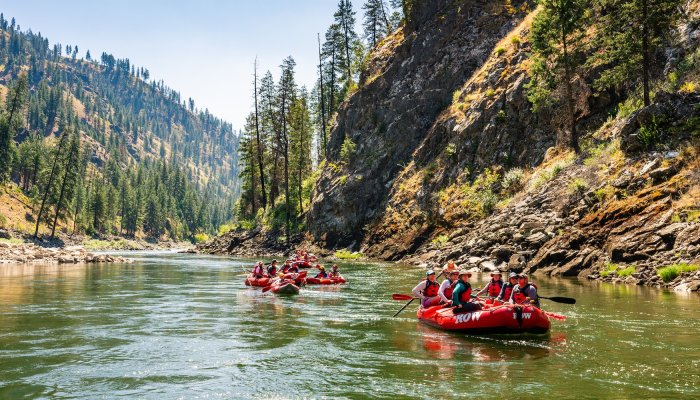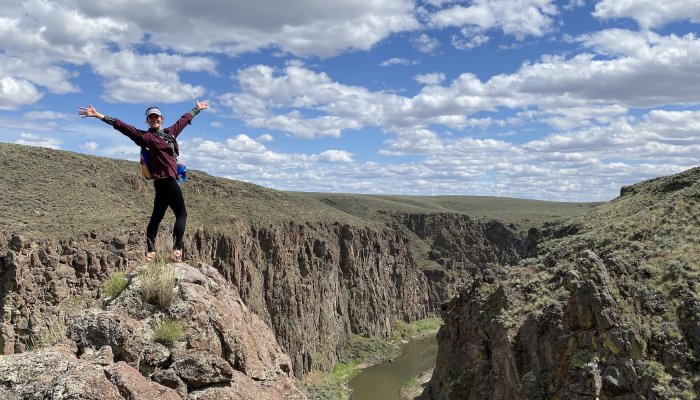What to Pack in Your Day Dry Bag on the River
On almost any rafting trip, you’ll want to pack a small “carry-on” dry bag filled with things you’ll need throughout the day. But with limited space and the need to keep items protected from water, it's important to be strategic and only bring the essentials.
In this article, we’ll share 8 items that every rafter should pack in their day dry bag, including everything from lip balm to snacks and a carabiner. By planning ahead and packing only the essentials, you'll have everything you need close at hand, leaving the rest securely stowed until reaching camp each night.

Sunscreen and Lip Balm
Rafting often means being exposed to the sun all day and, combined with the reflections coming off the water, this can lead to severe sunburn and heat exhaustion. Stay sun-safe on the water by layering on sunscreen and lip balm before you head out. Applying once a day isn't enough, it's reccommended to reapply every two hours—especially after swimming. A sunscreen stick or zinc offers great protection without the greasy feel, keeping your paddle grip secure.
Try to choose products with natural ingredients like beeswax, shea butter, and vitamin E to nourish your skin while being eco-friendly. If these items are stashed in your dry bag, you can easily reapply throughout the trip.

Extra layer and/or rain jacket
No matter how blue the skies look in the morning or how warm the forecast is, it’s wise to pack an extra layer (preferably a waterproof one) in your dry bag. Not only can the weather turn unexpectedly, transforming a pleasant float into a chilly adventure, but the spray from the rapids can make you much colder than you might expect.
Extra layers also help during the early morning hours before the rising sun has warmed the river gorge or channel. When no longer required, they can be stored away in your dry bag, ready for use again later in the day once the temperatures drop or the weather changes. Having a lightweight rain jacket will offer protection if the skies decide to open and shield you from the worst of the downpours.

Hat and sunglasses
Ideally, we recommend that you wear your hat and sunglasses at the outset of your rafting trip so you are protected from the get-go. But if the early morning conditions don’t require their use just yet, make sure you have them packed in your dry bag so they are easily accessible.
A wide-brimmed hat, such as a floppy sun hat, will shade your face and neck, as well as provide protection from glare coming off the water’s surface. Meanwhile, a good pair of sunglasses is a must for protecting your eyes from exposure to UV rays, as well as helping you see what is in front of you more clearly. Wraparound styles provide coverage from all angles while polarized lenses offer glare reduction. We highly recommend bringing sunglasses with a strap so you don’t lose them overboard!

Water bottle and locking carabiner
An easily accessible, insulated water bottle should be a top priority on any rafting trip, ensuring you stay hydrated throughout the day. While you can stash it directly in your dry bag, securing it to the exterior with a locking carabiner will mean you don’t have to fiddle around unfolding your dry bag and refolding it every time you need a drink. If accessing your water bottle becomes too difficult, you’re unlikely to rehydrate as much as you need.
Look for a durable water bottle made of stainless steel or plastic that can withstand getting banged around and preferably one that is insulated so your water will stay refreshingly cool. A wide mouth is a preferable feature as it makes it easy to drink on the go. Aside from securing your water bottle to your dry bag, it can also be clipped onto your lifeguard strap or the raft’s cargo netting using the carabiner.

Phone camera and waterproof case
If capturing photos of your rafting adventure is a priority, don’t forget to pack your phone or digital camera in your dry bag. That being said, there are no guarantees that it will stay dry while you’re taking photos, so it’s a good idea to take precautions and protect your electronic devices from the inevitable splashes and bumps.
Although some of the latest smartphone models boast impressive water resistance, you can't count on that alone. To be on the safe side, invest in a durable, waterproof phone case made of rigid plastic that fully encloses the phone and seals tightly to keep out moisture. Most importantly, make sure it allows you to still use the touchscreen and camera while inside!

Buff
The buff is a versatile piece of headwear that has become a staple accessory for outdoor enthusiasts and rafters. Made from a breathable fabric, these seamless, stretchy tubes can be worn in a multitude of ways, making them adaptable for various weather conditions and activities. The best part? They take up hardly any room in your dry bag and weigh next to nothing!
Worn around the neck, the buff serves as a scarf, keeping you warm and protecting you from wind or sun exposure during rafting trips. You can also pull it up over your mouth as a face mask or wear it as a headband to control wispy hair and sweat. Some buffs even have Insect Shield technology infused into the fabric to repel mosquitos, ticks, and other pests.

Granola bar or snacks
While most full-day and multi-day rafting trips include lunch, it’s a good idea to bring along some form of snack to keep you going. Protein or granola bars are a lightweight option that can easily be stashed in your dry bag and eaten during breaks on the river. With so many flavor options available, from peanut butter chocolate to coconut cashew, there's a bar to please every palate.
Alternatively, bring a piece of fruit, a few pieces of jerky, or a handful of dried fruit and nuts - whatever it is that gives you an energy boost and isn’t too time-consuming or messy to eat. Just remember that your dry bag may get tossed around while descending rapids, so avoid anything too soft, such as bananas.



